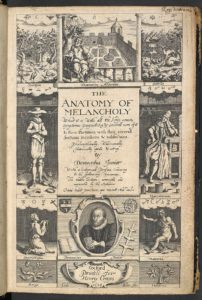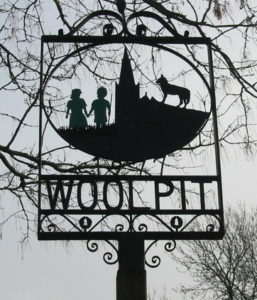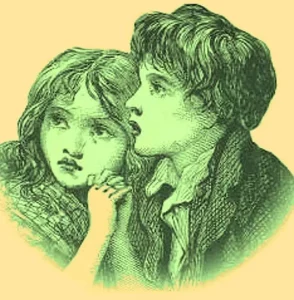The Green Children of Woolpit
English folklore is filled with green-themed stories: the Green Man, the Green Knight, Robin Hood, Jack-in-the-Green, and the Green Children of Woolpit. What’s even more interesting is that descendants of one of the green children may still be living in Suffolk, England.
The legend of the Green Children had its start during the reign of Stephen (1135-1154) or Henry II (1154-1189) in the Village of Woolpit in Suffolk, England. One fall, two reapers working near the old wolf pits (deep ditches dug to trap wolves) discovered two lost children, a brother and sister. The children had green-tinged skin, wore strange clothes and spoke an unfamiliar language. They were hungry, but both refused to eat regular food like bread.
The villagers brought them to the local lord, Sir Richard de Calne (or Caine), who agreed to take care of them. Sir Richard offered them food but they continued to refuse to eat. When the children found some green beans in his garden they immediately ate them. Richard de Calne took the children to a local church to be baptized. The boy died soon afterward of an unknown illness. Prior to death he went through a period of severe melancholy and lethargy. The girl, his older sister, regained her health and eventually lost her green-tinged skin. After she learned English, she told people about her origin:
“We are inhabitants of the land of St. Martin, who is regarded with particular veneration in the country that gave us birth. We are ignorant (of how we arrived here); we only remember this, that on a certain day, when we were feeding our father’s flocks in the fields, we heard a great sound, such as we are now accustomed to hear at St. Edmund’s, when the bells are chiming; and whilst listening to the sound in admiration, we became on a sudden, entranced, and found ourselves among you in the fields while you were reaping. The sun does not rise upon our countrymen; our land is little cheered by its beams; we are contented with that twilight, which, among you, precedes the sun-rise, or follows the sunset. Moreover, a certain luminous country is seen, not far distant from ours, and divided from it by a very considerable river.”
Agnes’ story was recorded by two 12th century chroniclers: Ralph of Coggestall (died c. 1228) and William of Newburgh (1136-1198). Ralph of Coggestall was the 6th abbot of Coggestall, a Cistercian monastery about 26 miles from Woolpit. He recorded his account of the green children in Chronicon Anglicanum (English Chronicle) around 1189 and claimed to have heard the story from Sir Richard de Calne himself. The Chronicon Anglicanun was written between 1066 and 1223. William of Newburgh was a monk and canon at the Augustinian Newburgh Priory in Yorkshire. He includes the green children in his main work, Historia rerum Anglicarum (History of English Affairs). His version reportedly came from many “trustworthy sources.” 
The story of the green children is mentioned in William Camden’s Britannia, published in 1586, and in two works from the early 17th century, Robert Burton’s The Anatomy of Melancholy (1621) and Bishop Francis Godwin’s fictional tale, The Man in the Moone (1638). The writers speculated that the children were inhabitants of another world, either subterranean or extraterrestrial.
Why were the Green Children green? This has been an unsolved mystery. The most plausible explanation is that the children were suffering from hypochromic anaemia, formerly known as chlorosis, which is caused by malnutrition and poor diet. The condition results in giving a green tint to the skin. This would explain why the girl, Agnes, lost her green skin over time as her diet changed.
Another idea, based on their early insistence on eating only green beans, is that their bodies were actually suffering from a condition called “favism” which is an allergy to bean plants. Favism attacks the kidneys and can result in a greenish pallor. It can be lethal, which explains the death of the boy.
A third explanation is that the children were poisoned by arsenic by an evil relative. Arsenic poisoning can tint the skin green. The green children came to be associated with the dark fairytale, Babes in the Woods, first published in 1595. It told the story of a wicked uncle who hires a couple of thugs to kill his orphaned niece and nephew so he can inherit their estate. The killers take pity on the children and abandon them in a forest, where they will get lost and eventually perish.
Who were the Green Children? There are lots of theories, both plausible and fantastic. They were beings from outer space. They were part of the Tuatha De Danann, a tribe of “shining beings” who were driven underground by the warlike Celts. The most likely theory is that they were children of Flemish immigrants who lived in the village of Fornham St. Martin, just north of Bury St. Edmunds, a town about ten miles away from Woolpit. In 1173, Fornham St. Martin was the site of a battle between Henry II and his son, Young Henry. Flemish mercenaries fought on the side of the rebels, and when they were slaughtered by the royalist forces, the Flemish settlers were probably targeted. If the children fled into nearby Thetford Forest, the dense canopy must have seemed like permanent twilight to them. Their town was close to the River Lark, which may have been the river Agnes described in her story. The area around Bury St. Edmunds is rife with underground flint mines, and the children may have wandered in these passages until they found themselves near Woolpit. The only problem with this theory is that living only 10-15 miles away, it’s hard to image that none of the Woolpit villagers, and especially Sr. Richard de Calne, had never been exposed to the Flemish language or dress. 
The young boy, unnamed, died shortly after being baptized. His older sister was baptized as “Agnes” and lived in the household of Sir Richard de Calne. When Sir Richard died around 1188, she was probably in her late teens or early 20s. She had a reputation of being “very wanton and imprudent.” William of Newburgh, who wrote one of the first accounts of the Green Children, said that she married a lawyer from King’s Lynn in Norfolk, about 40 miles from Woolpit. He said that she was still living when he wrote his account. Her husband may have been Richard Barre (1130-1202) who was a lawyer, clergyman and scholar. He was an ambassador for King Henry II, and later worked for King Richard I. The couple had at least one child.
Local Suffolk folk singer and writer, Bob Roberts, wrote about Agnes in his 1978 book, A Slice of Suffolk. “I was told there are still people in Woolpit who are descended from the green children, “ he wrote, “but nobody would tell me who they were!”


